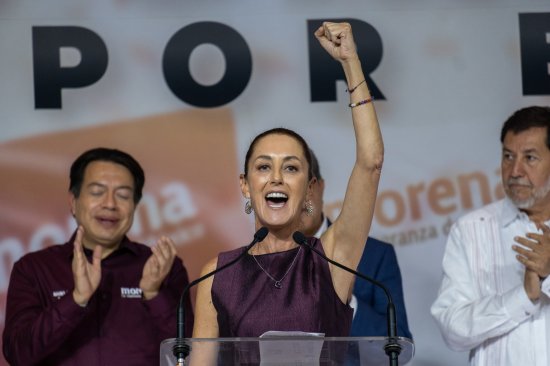
The country looks set to get its first female President, after Claudia Sheinbaum was chosen to be the ruling party's 2024 candidate.
Mexico’s ruling party has selected Claudia Sheinbaum as its candidate for next year’s election, pitting her against the opposition’s top contender, Xóchitl Gálvez. The decision means that the world’s largest Spanish-speaking country looks set to get its first female leader in 2024.
“This is a feminist’s dream,” Maricruz Ocampo, a women’s rights activist in Querétaro, told the Washington Post. The election “is going to signify a turn in the way that we see women in politics,” she added.
Sheinbaum and Gálvez both come from STEM backgrounds. Sheinbaum, who is Jewish, is a former physicist and was selected as the candidate for the center-left alliance Juntos Hacemos Historia, while Gálvez is a business woman and computer engineer with an Indigenous Otomí father and a mestiza mother running for the center-right political alliance Broad Front for Mexico.
[time-brightcove not-tgx=”true”]“They really made it on their own. This is their own momentum and career trajectories,” says Christopher Sabatini, a senior fellow for Latin America at Chatham House.
In many Latin American countries, several female candidates for head of state have been wives or ex-wives of popular male candidates. In Argentina, former President Cristina Fernández de Kirchner took office directly after her husband’s term ended in 2007. In Honduras, the current President, Xiomara Casto, is the wife of former Honduran President Manuel Zelaya. And in Guatemala, the runner up of last month’s election, Sandra Torres, is a former First Lady, who divorced her husband Álvaro Colom to get around campaign laws that prevent relatives of the President from running for the role. “I am not going to be the first or the last woman who decides to get a divorce, but I am the only woman to get a divorce for her country,” she said at the time.
Given this context, Mexico’s political landscape is even more unique, Sabatini says. He adds that Mexico is ahead of the curve when it comes to women in politics, even at the lower levels of government, like state officials and members of parliament. Currently, half of all national parliament seats in Mexico and half of the government’s cabinet positions are held by women; the country fares less well on governorships, with nine of the country’s 32 of them being women.
Mexico’s advances in women’s representation have roots in events that occurred in the 1990s, when the country’s 71 years of one-party rule under the Institutional Revolutionary Party (PRI) began to come to an end amid corruption scandals and economic crises. In the aftermath, many Mexicans felt eager for political leadership that was vastly different from what they had experienced before, Sabatini says.
It was also during this time that civil society organizations that focused on women’s issues became more outspoken.
“Out of the repression, control, and monopolistic exercise of power through what was effectively a one party government from 1921 until 2000, you had this emergence of a very active, engaged civil society that helped propel a number of issues, abortion being one of them and women’s representation being another,” Sabatini says.
On Wednesday, women’s rights activists celebrated a major win after Mexico’s Supreme Court decriminalized abortion nationwide. The ruling opens the door for the healthcare system to provide abortions. “That’s why today’s decision of the Supreme Court is important,” women’s rights activist Sara Lovera told Agence-France Presse.
Following the end of one-party rule, lawmakers introduced quotas for the number of women in political positions. “They were adjusted to increase not just the representation of women on national tickets, but also the distribution on those tickets,” Sabatini says. “So it’s, in many ways, Mexico’s adoption of these pro-women representation laws has gone beyond that of many other countries because it extends to cabinets and statewide.”
Still, the country’s role as a regional leader for women’s political representation doesn’t mean it doesn’t grapple with significant inequality. On the U.N.’s gender equality index, Mexico scored a 0.309 on a scale of zero to one, with zero representing the most equality.